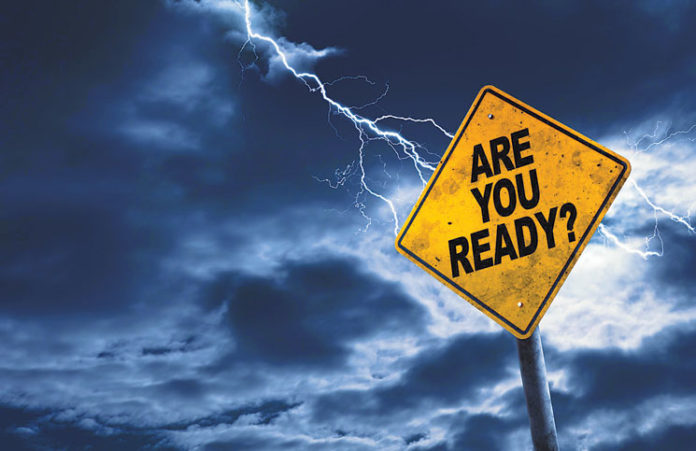In the wake of hurricanes Harvey, Irma and Maria, emergency preparedness and management of environmental disasters are a cause for concern and examination nationwide.
A panel of local emergency preparedness experts and professionals weighed in on common mistakes and what they wish business owners and citizens knew. The first common thread was just how often people don’t heed official warnings.
“The biggest thing I see is people not listening to warnings,” said Eric Frank, emergency management coordinator for Clark Regional Emergency Services Agency (CRESA). “We as a species, we look at the hazards and risks coming and compare it to things we’ve seen in our past. We see a lot of that with comparing, ‘this was a category 5 in the past, it only did this.’”
Michelle Week, field instructor specializing in urban emergency preparedness at REI, echoed this sentiment, “Abiding by warnings, adhering to warnings. If you know there’s going to be a thunderstorm you don’t climb to the top of a mountain, you don’t expose yourself to those elements. The same goes for down in the city.”
While hurricanes are unlikely, the Pacific Northwest has its own host of environmental hazards to prepare for.
“For our region, we could encounter anything,” Week said. “From wildfires and earthquakes, to tornadoes and tsunamis. Being prepared for anything and everything is really our main goal.”
Nina Rubenstein, emergency management coordinator at PeaceHealth, stressed the importance of personal preparedness.
“We need our staff to report to the hospital if an incident like that were to take place,” Rubenstein said. “Because that would be an all-hands-on-deck sort of situation. But if our staff isn’t confident that their homes are prepared to sustain without their presence, then their presence is going to stay there. And that’s a totally human response. So, my big push now is encouraging personal preparedness, handing out information about how you build a kit at home, how you make a plan for your family …”
Week recommends gathering up essentials and creating kits to have in a variety of locations.
“(Essential items that people sometimes don’t always think to include) are old pairs of running shoes or old eye glasses, which are good things to hold on to,” Week said. “I have a minimum of four to five different kits. One kit for your car, one for your home, one for the office, one for a second location in case you’re not at any of those locations and you need to get somewhere where there are supplies. In the office and in the car, the old pair of running shoes that you don’t want to run in anymore but are still technically good are great to have on hand because walking around in fancy shoes or office shoes is going to get uncomfortable. If you do have to evacuate the building and have to hike to another shelter or building where supplies and aid is available, you’re going to want something more comfortable than those shoes.”
“Every business and organization should be engaged in emergency preparedness planning,” said Lenda Crawford, Vancouver deputy city manager. “Businesses need to develop emergency and disaster recovery plans, make sure facilities are safe, structurally sound and can withstand a major environmental disaster, and train and drill employees. Everyone should have emergency kits that include water, a battery-operated radio, nonperishable foods, essential medications, blankets and extra clothing, a light source and a first aid kit.”
Experts say that taking care of employees should be a top concern for all business owners. With so many pieces to consider, being sure that basic needs can be met is essential.
“One of the best things you can do in your planning is understand how you can take care of your own people,” Frank said. “What kind of plans do you have in place getting your employees back and forth, or having them accounted for? If you have a lot of product on hand that could be perishable, what are your plans for distribution so it doesn’t go to waste and it can be useful in the community?”
Beyond addressing a plan and having basics on hand, businesses should also be prepared to address hygienic issues.
“Businesses should have back-up sanitation toilets, probably for every 10-12 people,” Week said. “You’ve got to address that, having sanitation available. They may not be able to address everyone’s shoe size or comfort level in those ways … but businesses are held accountable for at least that standard three days. Three to five days is ideal. So, how do you set up proper sanitation to avoid other viruses and diseases that are really the ultimate downfall of an urban disaster.”
However, Rubenstein doesn’t want to cause panic about the three-day recommendation. While it is a minimum requirement, certain organizations, PeaceHealth among them, do have partnerships and plans in place for replenishment in the event of a disaster.
“It’s a national requirement that every hospital has to have power sustained for 96 hours,” Rubenstein said. “We all have to have generators that have 96 hours of fuel in them. That does not mean that at 96:01 the generator breaks down never to be used again. It’s a requirement that our fuel will be replenished in that event. We have on hand those four days of fuel, but we can sustain for longer than that.”
In the case of a major disaster, personal preparedness remains paramount when one starts to examine the math.
“For us to have a resilient community after any type of disaster it really is a partnership,” Frank said. “The reality is that we have very limited resources. There’s no way that we could be able to meet all of those needs by ourselves. There are over 470,000 people in the county and government is just a small sector. There are less than 40 first responders, firefighters and police officers on the street at any given time. There’s eight to 10 lines coming into the 9-1-1 center, you understand that those impacts, large scale, it’s going to be people relying on each other during a disaster or an emergency.”
“There’s only 5 to 10 percent of the population that is totally trained to handle serious medical emergencies and they themselves may be experiencing those serious medical injuries, so then you’re talking about even less of a percentage of the population that will be able to respond and help other people in those serious conditions,” Week said. “So, don’t add to it. Don’t clog up the streets. Be prepared to walk not drive to and from places. I always encourage people to do that. Take the bus or walk or bike to and from work, to and from their children’s school, wherever, even if it’s just a weekend trip. Just so they have a better idea about the lay of the land and how to get around. Walk around your office building. Being able to get a lay for that land is huge because it’s all going to change anyways, but at least you have some base work to work off of and not get further lost.”
“We want people to be aware that at least a third of small businesses do not recover after a disaster,” Frank said. “We want to enforce the importance of them having a plan in place and understanding what type of continuity pieces do they have together.”



